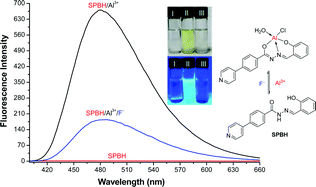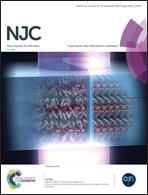Acylhydrazone as a novel “Off–On–Off” fluorescence probe for the sequential detection of Al3+ and F−†
Abstract
A new acylhydrazone fluorescence probe, SPBH, was synthesized from salicylaldehyde and 4-(pyridin-4-yl)benzohydrazide (PBH). SPBH exhibited high selectivity and a sensitive fluorescence response towards Al3+, even in the presence of other competing metal ions in DMF/H2O (1 : 1, v/v) medium. And, the chemosensor can even detect Al3+ in the intracellular region of human non-small cell lung cancer H460 cells. The binding phenomenon of SPBH was investigated by 1H NMR spectroscopy and HR-MS. Mass spectrometry analysis showed a 1 : 1 complex formation of SPBH with Al3+. The Job plot also confirmed its 1 : 1 interaction. This SPBH/Al3+ complex exhibited excellent fluorescence “turn-off” properties towards the F− anion. Thus, SPBH acts as a sequential fluorescence “Off–On–Off” probe. The limits of detection for Al3+ and F− were calculated from the titration curve and found to be 1.1 × 10−7 M and 1.47 × 10−6 M, respectively.



 Please wait while we load your content...
Please wait while we load your content...